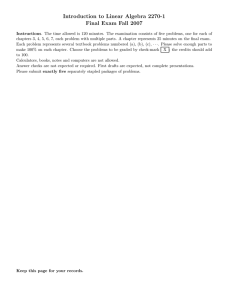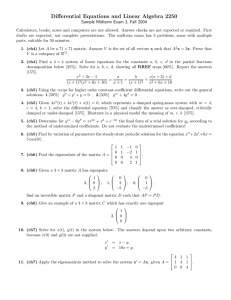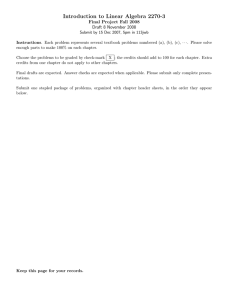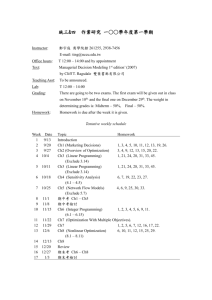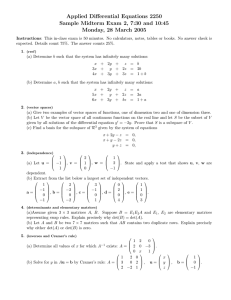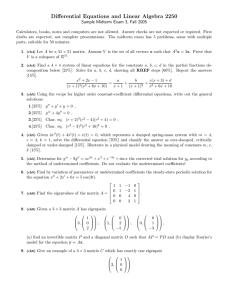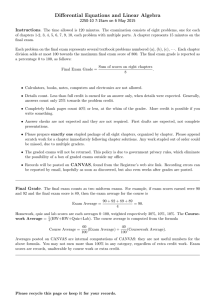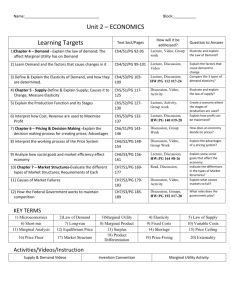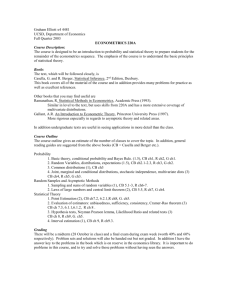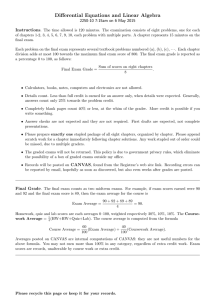Introduction to Linear Algebra 2270-1 Sample Final Exam Fall 2007
advertisement
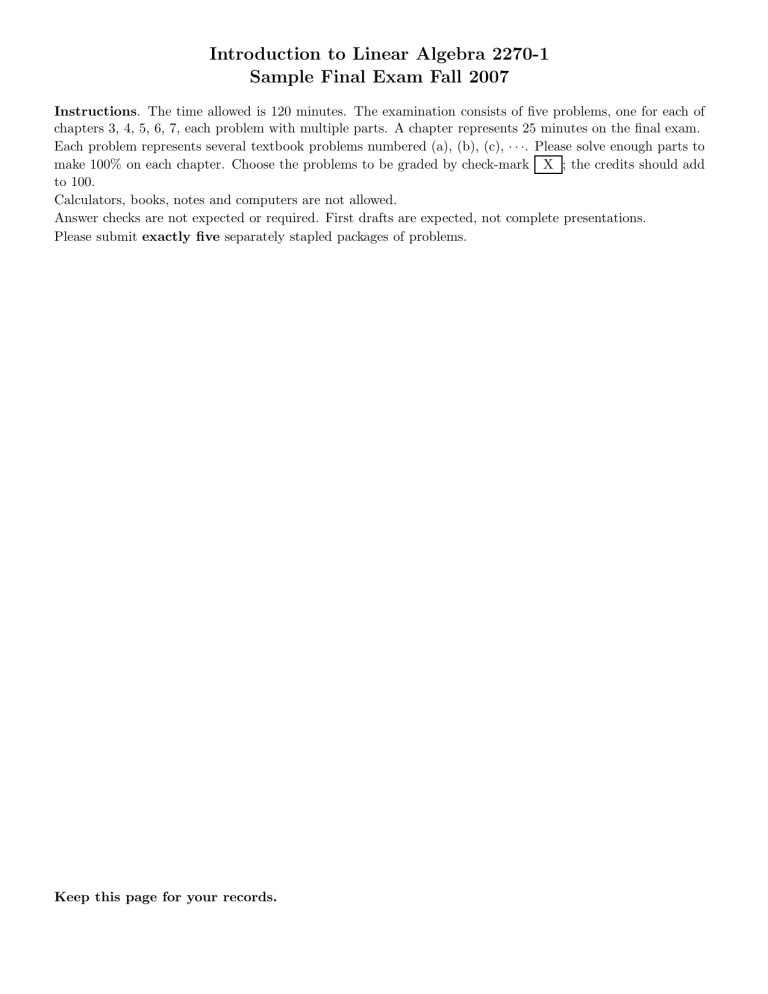
Introduction to Linear Algebra 2270-1 Sample Final Exam Fall 2007 Instructions. The time allowed is 120 minutes. The examination consists of five problems, one for each of chapters 3, 4, 5, 6, 7, each problem with multiple parts. A chapter represents 25 minutes on the final exam. Each problem represents several textbook problems numbered (a), (b), (c), · · ·. Please solve enough parts to make 100% on each chapter. Choose the problems to be graded by check-mark X ; the credits should add to 100. Calculators, books, notes and computers are not allowed. Answer checks are not expected or required. First drafts are expected, not complete presentations. Please submit exactly five separately stapled packages of problems. Keep this page for your records. Name 120 2270-1 Final Exam, 11 Dec 2007, 7:30-10:15am JTB Ch3. (Subspaces of Rn and Their Dimensions) 1 0 1 1 [30%] Ch3(a): Let A = 2 1 1 0 . Find bases for the image and kernel of A. 1 1 0 −1 1 0 1 [40%] Ch3(b): Let v1 , v2 , v3 the columns of the matrix A = 0 1 1 . Define T (x) = Ax. 1 1 0 Find the matrix of T relative to the basis v1 + v2 , v2 + v3 , v3 + v1 . [30%] Ch3(d): Let V be the vector space of all functions f (x) defined on 0 ≤ x ≤ 1. Let S be the R subset of V defined by f (1) = f (0) + 01 xf (x)dx, f (0.5) = 0. Prove that S is a subspace of V . f [40% or 30%] Ch3(d): Let V be the vector space of all data packages v = x0 , where f is a y0 continuous function defined on 0 ≤ x ≤ 1 and x0 , y0 are real values. Define + and · componentwise. Let S be the subset of V defined by f (0) = f (1), 2x0 + y0 = 0. Prove that S is a subspace of V . Please start your solutions on this page. Staple on additional pages. Name 120 2270-1 Final Exam, 11 Dec 2007, 7:30-10:15am JTB Ch4. (Linear Spaces) 1 [30%] Ch4(a): Let x = 1 . 0 Let W be the linear space of all 3 × 3 matrices. Let V be the set of all 3 × 3 matrices A such that x belongs to the image of A. Prove or disprove: V is a subspace of W . [40%] Ch4(b): Let V be the linear space of all functions f (x) = c0 + c1 x + c2 x2 . Define T (f ) = c2 x2 from V to V . Find the image, kernel, rank and nullity of T . [30%] Ch4(c): Let V be the linear space of all real 4 × 4 matrices M . Let T be defined on V by T (M) = N where N = M except for the last row, which is all zeros. Find the image and kernel of T . ! ! 1 3 1 −2 [40%] Ch4(d): Let A = , S = and D = diag(1, −1). Then AS = SD. 0 −1 0 2 Define V to be the linear space of all 2 × 2 matrices R satisfying AR = RD. Find a basis for V . Please start your solutions on this page. Staple on additional pages. Name 120 2270-1 Final Exam, 11 Dec 2007, 7:30-10:15am JTB Ch5. (Orthogonality and Least Squares) [30%] Ch5(a): Find the orthogonal projection of v onto V = span(v1 , v2 ), given v= 9 0 0 0 , v1 = 0 4 −1 0 , v2 = 0 4 1 0 . [10%] Ch5(b): Let A be 4 × 5. Prove or give a counterexample: dim im(A)⊥ = dim ker AT [10%] Ch5(c): Let A be n × m. Prove or give a counterexample: ker(A) = ker AAT . . [30%] Ch5(d): Consider the linear space V of polynomials f (t) = c0 + c1 t + c2 t2 + c3 t3 on 0 ≤ t ≤ 1 with inner product Z 1 f (t)g(t)dt. < f, g >= 0 Find a basis for the subspace S of all f in V orthogonal to both t and 1 + t. [30%] Ch5(e): Find the Gram-Schmidt orthonormal vectors w1 , w2 , w3 for the following independent set: 1 1 0 1 0 −1 v1 = , v2 = , v3 = . 0 0 0 1 0 −1 4 10 0 0 −1 . [30%] Ch5(f): Find the QR-factorization of A = 0 3 −10 0 [30%] Ch5(g): Derive the normal equation in the theory of least squares. [30%] Ch5(h): State and prove the Near Point Theorem. Please start your solutions on this page. Staple on additional pages. Name 120 2270-1 Final Exam, 11 Dec 2007, 7:30-10:15am JTB Ch6. (Determinants) [50%] Ch6(a): Let B be the invertible matrix given below, where ? means the value of the entry does not affect the answer to this problem. The second matrix C is the adjugate (or adjoint) of B. Find the value of det(2B −1 (B T )−2 ). B= ? ? ? 0 0 −1 2 0 1 1 0 0 ? ? ? 3 , C= 6 6 12 0 −6 −6 6 0 −3 6 3 0 2 2 4 −6 [25%] Ch6(b): Assume A = aug(v1 , v2 , v3 ) is 3 × 3 and B = aug(v1 + v3 , v3 − v2 , 2v2 − v3 ). Suppose det(A + B) + (det(A))2 = 0. Find all possible values of det(A). [25%] Ch6(c): Assume given 3 × 3 matrices A, B. Suppose E5 E4 B = E3 E2 E1 A and E1 , E2 , E3 , E4 , E5 are elementary matrices representing respectively a a combination, a multiply by 3, a swap and a multiply by 7. Assume det(A) = 5. Find det(5A2 B). [25%] Ch6(d): Find the area of the parallelogram formed by v1 , v2 , given v1 = 1 1 ! , v2 = ! −1 2 [25%] Ch6(e): Evaluate det(A) by any hybrid method. A= 1 1 2 0 −1 −1 1 0 −1 2 1 0 1 1 2 −3 Please start your solutions on this page. Staple on additional pages. . Name 120 2270-1 Final Exam, 11 Dec 2007, 7:30-10:15am JTB Ch7. (Eigenvalues and Eigenvectors) [30%] Ch7(a): Find the eigenvalues of the matrix A = not find eigenvectors! 4 −2 1 12 2 4 −3 15 0 0 3 7 0 0 −1 −5 . To save time, do 1 1 −1 1 , assume there exists an invertible matrix P and a diagonal [30%] Ch7(b): Given A = 0 3 0 1 3 matrix D such that AP = P D. Circle all possible columns of P from the list below. 2 1 , 1 1 0 , 0 0 −1 . −1 [40%] Ch7(c): Consider the 3 × 3 matrix 4 2 −2 1 . A= 0 3 0 1 3 Already computed are eigenpairs 1 4, 0 . 0 2 −1 2, , 1 (1) [25%] Find the remaining eigenpairs of A. (2) [5%] Display an invertible matrix P and a diagonal matrix D such that AP = P D. (3) [10%] Display explicitly Fourier’s model for A. [40%] Ch7(d): Consider a discrete dynamical system x(n + 1) = Ax(n). Given A and x(0) below, find exact formulas for the vectors x(n) and limn→∞ x(n). 1 A= 10 7 1 −2 10 ! , x(0) = Please start your solutions on this page. Staple on additional pages. 40 50 ! .
